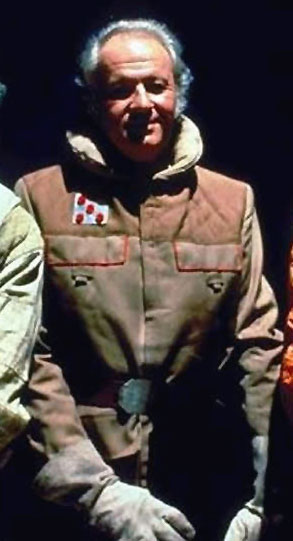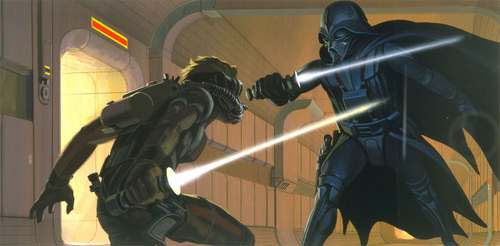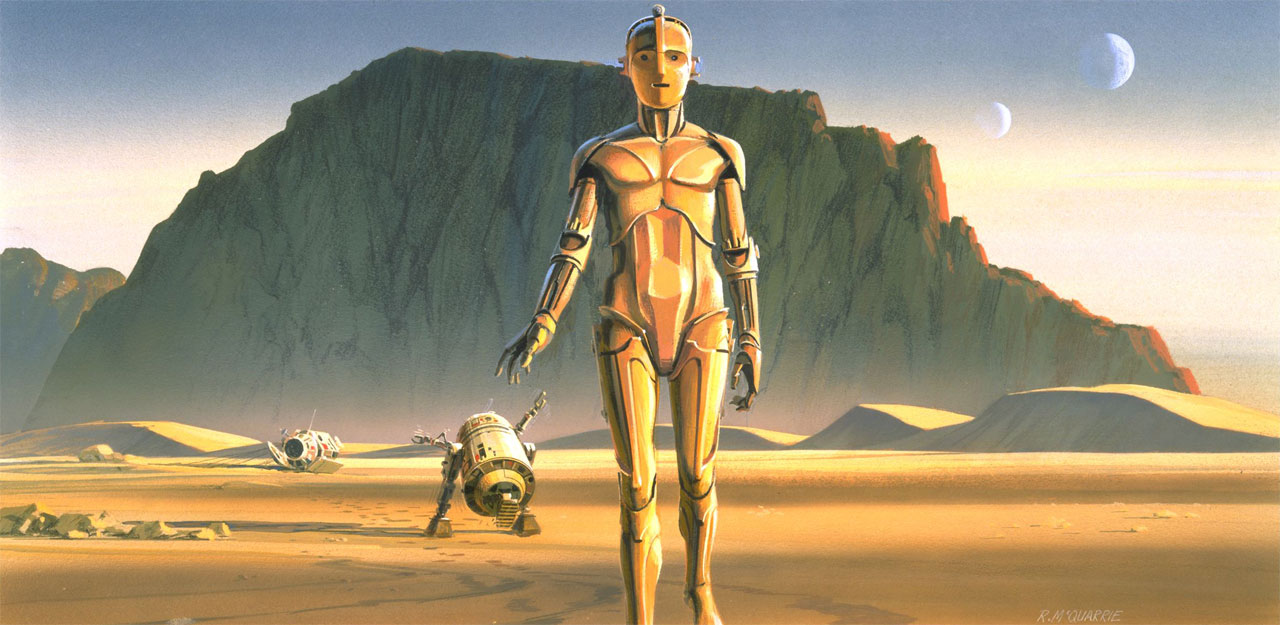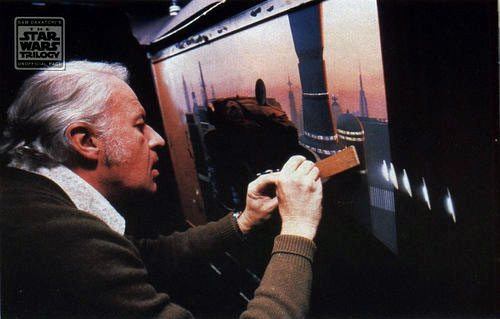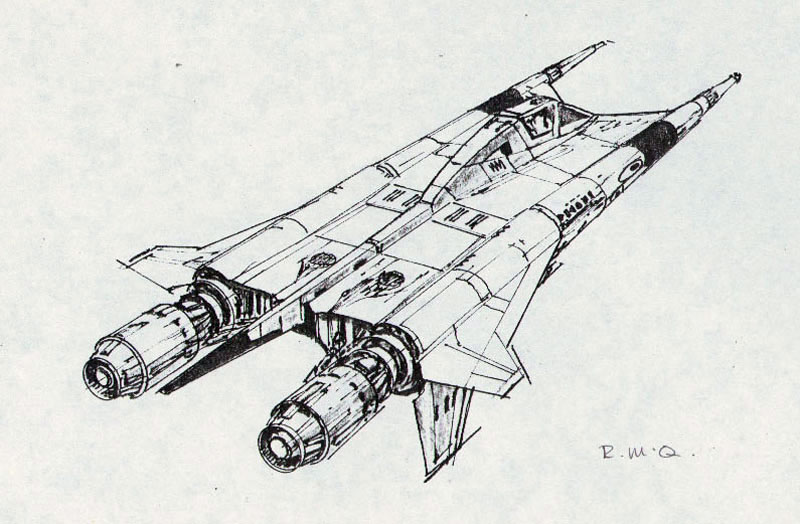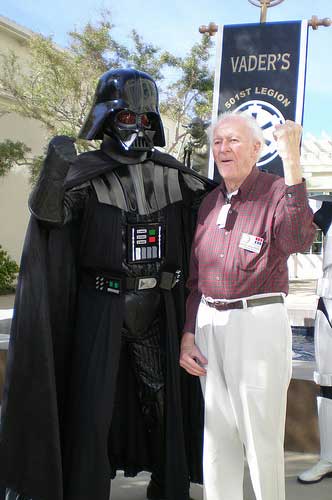
|
The Eighth Annual Dead Man of the Year Award...
By J.C. Mašek III 

From the Canvas... to the Stars
The 2012 Dead Man goes to the incomparable... Every year for the past seven years, fans have flocked to WorldsGreatestCritic.com just after January 1st for the most popular tradition on this website. Then they double check their calendars, confirm they have the date right and mumble frustrated nothings into the air. What happened to this website. Is that guy who runs it dead? No, but I am still bringing you The Dead Man of the Year award. Remember that first year in 2005 when the award went to Willis H. O'Brien or the next time out in 2006 when Jerry Siegel and Joe Shuster had to share theirs? Who could forget the surprise win by Phil Hartman in 2007 or the 2008 upset by Stan Winston? Let's not forget 2009 when Majel Barrett beamed her award up to Heaven, or 2010 when Leslie Nielsen swooped down from the sky in his Airplane! to claim the prize. Last year's KING, Jack Kirby's influence was so strongly felt throughout 2012 that he almost became the first ever DMOTY double winner. For those of you keeping score, that's two special effects magicians, three thespians and three comic book artists. If that sounds like we're in a rut, that's because, hey, we're talking about the world of Entertainment here, and we writers hate to give each other anything. So who could possibly win this year? The 2012 winner is something of a combination of all of the previous winners. Ralph McQuarrie created the designs that informed some of the most amazing special effects in cinema history. He was an incredible visual artist and painter who designed some of your favorite scenes and even characters. McQuarrie has three Visual Effects credits in his own right. In a rare acting moment, Ralph McQuarrie even became a character himself, and walked among many of the characters he designed in The Empire Strikes Back. In fact, it's safe to say that if you're anywhere around my age, Ralph McQuarrie is the man who drew a big chunk of your childhood. One might wonder how any place on Earth could have given rise to an artist who designed the imagery from Star Wars, Battlestar Galactica, Close Encounters of the Third Kind, E.T. The Extra-Terrestrial, Cocoon and more. One might expect such a dreamer to have been from the stars himself. However Gary, Indiana, Gary, Indiana (not Louisiana, Paris France or even Rome) but Gary Indiana, Gary Indiana, Gary Indiana was Ralph Angus McQuarrie's home sweet home, starting with his birth on June 13, 1929. He wasn't raised around high technology, but on a farm outside of Billings, Montana. McQuarrie's parents were both artists and he began drawing and watercoloring at a very young age. At the age of 10, young Ralph began his professional training and in High School he was already an accomplished technical artist. It was during this time that the young art lover began to reach for the sky. He became fascinated with flight and space exploration, interests that surely informed his later career. After high school, McQuarrie served in the United States Army during the Korean War and also saw combat, surviving a bullet to the head (which had pierced through his helmet). When Ralph returned from the war, he took his experiences with him to California where he studied at Art Center (now known as Art Center College of Design) in Los Angeles. McQuarrie's first work was for a dental firm where he drew teeth and dentists' tools. Soon he took his Industrial Design skills to firms like Kaiser Graphics and watched them soar when he took a job for the Boeing company.At Boeing, McQuarrie drew diagrams for manuals instructing mechanics on how to build jumbo jets. Even early in his career, McQuarrie was building flying machines from the inside out. Is it any wonder that his space designs feel as realistic as they do fantastic? At this same time, Ralph started a studio with two other artists called "Reel Three" and began his first work in relation to motion pictures: designing movie posters. Soon, Ralph McQuarrie's artwork went soaring beyond the atmosphere into space as he animated the NASA and CBS News coverage of the Apollo space missions. Let's tick those off really quick. A young man, raised on a farm with dreams of flight and outer space becomes a technical and industrial artist. Before his 40th birthday, he is already drawing airplanes professionally, painting movie posters and animating the Apollo capsule on national television. From the Farm to the Stars? The man was Luke Skywalker with a paintbrush. Because of these dreams and these realities, Ralph McQuarrie was an obvious choice for concept artist and production designer on a risky science fiction film, being brought to life by a young film student from USC, who was good friends with John Milius and would later collaborate with Steven Spielberg. That young man was, of course... NOT George Lucas (and the film was not Star Wars). No, the filmmaker in question was Hal Barwood along with his frequent collaborator Matthew Robbins and their sci-fi film-to-be was called Star Dancing. Ralph McQuarrie did some great concept paintings for the project to help it get financing. Although Star Dancing ultimately never made it past the planning stages, the work McQuarrie did for that film was noticed by another good friend of Barwood and Robbins who was working on a science fiction fantasy of his own. This time, yes, it was George Lucas and it was Star Wars he was working on. Lucas and McQuarrie collaborated on a few ideas before The Star Wars, as it was then-known, was, itself, shelved for a time while Lucas worked on his second film (after THX 1138) known as American Graffiti. McQuarrie didn't hear much from the soon hit-making Lucas for a couple of years and chalked the initial meeting up to a missed opportunity. In the meantime, Lucas had become frustrated with studio executives at United Artists and Universal Studios. Both studios had been interested in The Star Wars but the executives at both studios failed to visualize the images Lucas had created in his mind. Luckily, Lucas knew of an incredible artist who was both fanciful and mechanical in his designs. Thus in 1975, Lucas and McQuarrie began what what would become a monumental partnership. To film fans everywhere, this partnership was a milestone in myth making. For Ralph McQuarrie, however, at that time it was just a job. McQuarrie really liked the ideas George Lucas gave him for Star Wars but he was also realistic. No movie that expensive could be made and if it was, it wouldn't be a financial success because there just wasn't an audience big enough to support a high-concept Science Fiction movie. Although McQuarrie didn't think the film would ever get made, he did give his all to the project and allowed his imagination to flow. Pop quiz, everybody... Why does Darth Vader wear that helmet and breathing mask? Because Anakin Skywalker was burned horribly by lava after an epic battle with Obi-Wan Kenobi and he needs the suit to survive (and Lucas had that in mind all along)? If that's your answer, you're dead wrong. Yes, that became the in-universe explanation later on, but the real reason was Ralph McQuarrie's thinking cap. Reading the initial drafts of Lucas' Star Wars articles, Vader was an older, white haired, uniformed military general whose imagery more closely resembled the character of Grand Moff Tarkin. The script that McQuarrie worked from didn't have a great deal of description of Vader (who was, of course, not yet cast) but Ralph did note that Vader was scripted to move from the Imperial Star Destroyer to the Rebel ship Tantive IV through, he assumed, the vacuum of space. Thus McQuarrie drew Vader with the flared helmet and mask that he would become famous for as part of the character's space suit. McQuarrie never meant the mask and helmet to be a permanent part of the character's costume and may have intended these to be seen in one sequence only but Ralph McQuarrie's practical wisdom, coupled with his brilliant imagination made him the real father of Darth Vader as we know him. Without McQuarrie, Vader would have been a vastly different character. Without that helmet, the tense sight-gag of the scarred back of Vader's head in Empire Strikes Back would never have been attempted. Without that moment, we may never have had the burning fate of Anakin Skywalker. In short, without Ralph McQuarrie's imagination the CENTRAL THREAD to the ENTIRE Star Wars storyline would never have happened. McQuarrie did more than design Vader. He also drew the concept artwork for several more characters, vehicles and sets. McQuarrie was responsible for the design of the jawas' Sandcrawler and the insides of the Death Star and the Creature Cantina (amongst other locations). McQuarrie drew the first images of Stormtroopers (famously wielding Light Sabers in his version) along with a monstrous version of Greedo, a bearded Han Solo (also with a light saber) with his even bigger, rounder and more alien best buddy Chewbacca and images of the young, idealistic hero of the saga to be whose name (and gender) repeatedly changed before he/she became Luke Skywalker. Some of McQuarrie's concept art featured this character as a female before Luke was finalized. Almost equal in note to the Vader concepts are the stunning designs of C-3PO and R2-D2 arriving on the desert planet of Tattooine. That image of the droids in the desert is widely credited as one of the trump cards that got the green light for Star Wars at its new studio, 20th Century Fox. McQuarrie's art was modified by the time it was realized for the big screen sometimes a little, sometimes a lot. The original C-3PO more closely resembled Maria from Metropolis and R2-D2 had arms (which would show up in the films later on). Han was cast as the clean-shaven Harrison Ford and Chewie became a more streamlined, familiar figure. However his mark was left on each of them... and none of these characters would have been quite the same without him. This is especially true for Darth Vader whose angry, angular design was evened out slightly, but was otherwise unchanged for the screen. In addition, Ralph McQuarrie was heavily involved with the production of the special effects of Star Wars. The dread Death Star had to appear flat in close up shots, such as the X-Wings' strafing runs, but had to appear spherical from a distance. In order to perfect the dimensions, it was McQuarrie who calculated the size of the Death Star to aid the effects crew in scaling. According to McQuarrie's calculations, the space station would be 290 miles in circumference and a full 92 miles in diameter. No wonder Vader took Obi-Wan down. The man was tired from all that walking to and from the tractor beam. The future of Star Wars was still yet to be seen, but any doubt Ralph McQuarrie or anyone else had disappeared soon after May 25, 1977. To call Star Wars a hit would be like calling Mount Rushmore a bit of carved stone. The first feature film Ralph McQuarrie worked on that made it to the big screen broke every box office record up to that time and made McQuarrie a superstar in the conceptual art world, leading to his work on the next two Star Wars movies. In the meantime, however, McQuarrie was hardly resting on his laser swords. Before Star Wars hit the big screen in 1977, McQuarrie was already hard at work on the re-design of another iconic Science Fiction saga, Star Trek, as it made the jump through hyperspace to the big screen. Much as we saw in Star Trek: The Motion Picture, the Enterprise from the version of the Star Trek movie McQuarrie worked on (Star Trek: Planet of the Titans) had undergone a refit in between its last television incarnation and the film. The Enterprise Ralph contributed concept art to was a much more heavily re-designed spacecraft with its central cylinder replaced by a long, wide triangle, very similar to the design of the Star Wars Star Destroyers. While Planet of the Titans never did come to fruition, McQuarrie's version of the Enterprise (on which he collaborated with Ken Adam) was eventually seen onscreen. The study model designed for the film appeared as the Federation starship B-24-CLN in the Star Trek: The Next Generation episode "Unification Part 1". Around the same time, Lucas' friend Steven Spielberg asked McQuarrie to design the ships in his new Science Fiction film Close Encounters of the Third Kind, based on his work on Star Wars. McQuarrie took inspiration from the refineries along the 405 Freeway in Long Beach, California for the crowded top of the penultimate ship in the film. Another Star Wars connection, for the watchful eye can be seen among these ship-topping towers as the vessel begins to turn over. Watch closely and R2-D2 can be seen amid the chaos. By this time, McQuarrie was the very definition of "in demand". When Universal and ABC Television began work on the space saga, part Star Trek, part Star Wars and part Book of Mormon, it was Ralph McQuarrie that they called. McQuarrie provided early concept work on the series, including planetscapes, spacecrafts, early (very different) versions of the Cylons and the first version of the Viper craft. Many of these designs went on to be reused in the TV show Buck Rogers in the 25th Century and the Battlestar Galactica reimagining that started in 2003. Battlestar Galactica's production company Universal Studios was eventually sued by 20th Century Fox for plagiarism, unfair competition and copyright infringement for its perceived 34 distinct stolen ideas from Star Wars. With Ralph McQuarrie on both sagas, it's not hard to see where many of these similarities came from. McQuarrie didn't stay with Galactica long, because Lucasfilm called again, this time for The Empire Strikes Back. McQuarrie was ready for this call, and even had a proviso in his Galactica contract that allowed him to leave for any Star Wars sequels. Much of the concept artwork for this second Star Wars film was produced by McQuarrie, including most of the scenes on Hoth. Certain frames are almost direct translations of McQuarrie's paintings. Concept art from the first Star Wars in which the film's young hero crosses lightsabers with Darth Vader informed the duel on Cloud City. And while Joe Johnston is often credited as the designer of the iconic bounty hunter Boba Fett, early designs of the armored scoundrel as a Stormtrooper variant were drawn by Ralph McQuarrie. It was these early Fett designs that later informed the look of the prequel trilogy's Clone Troopers. Notably Ralph McQuarrie also cameoed in The Empire Strikes Back, walking in front of a matte painting he created himself. Years later an action figure named "General McQuarrie" would be produced in tribute to Ralph's appearance in the film. Thus far, McQuarrie's brush had touched four major sagas. He was still years from retiring. Spielberg and Lucas collaborated on a little film that starred Harrison Ford called Raiders of the Lost Ark in 1981. The Ark we see in the film was based on written descriptions of the vessel from antiquity, but the adapter of those descriptions was Ralph McQuarrie who drew the first concept art of the Ark for the film. Another big Spielberg film was E.T., which featured a huge mother ship nicknamed "The Ornament". Yes, indeed, folks, The Ornament was designed by none other than Ralph McQuarrie. Even as Raiders and E.T. were being made, McQuarrie was working on the third Star Wars film, entitled Return of the Jedi. His contributions were some of his most substantial to any movie to date. McQuarrie's design of the inside and outside of Jabba the Hutt's palace and sail barge were preserved almost completely intact for the big screen. Luke's battle with the Rancor monster and his meeting with Emperor Palpatine are also almost exactly lifted from Ralph's conceptual designs. Ralph McQuarrie had already become one of the most successful concept artists in Hollywood, and with good reason. With his next film, however, McQuarrie was about to receive a new level of recognition. Ron Howard's 1985 science fiction tale Cocoon was about senior citizens like Wilford Brimley, Hume Cronyn and Jessica Tandy finding new life, health and virility thanks to the title cocoons owned by glowing aliens. The film was a great success with fans and critics. Most lauded of all was its conceptual artist Ralph McQuarrie who received a Best Visual Effects Oscar for his work on the film. One somewhat obscure factoid in the history of Ralph McQuarrie's art came during an indefinite production hold on the film Cocoon. Not knowing if the hold was to be for a week or a month, Ralph accepted the offer he previously turned down from director Gary Goddard to work on his film Masters of the Universe. As with Battlestar Galactica, McQuarrie had an agreement with Goddard that he would work on Masters of the Universe for as long as he could until and unless the work on his previously contracted film was to resume. Resume, Cocoon did after only four weeks, but not before McQuarrie contributed some beautiful ship, costume and character designs to the Masters of the Universe film. Post-Cocoon, McQuarrie worked on the short film Discovery (1986) before returning to another universe he had visited before, contributing production designs to Star Trek IV: The Voyage Home (1986). This time his imagery did make it to the screen on time. The following year, saw the release of the sci-fi comedy *batteries not included which returned the team of Cronyn and Tandy to the big screen and featured the tiny robot space ships, all designed by Ralph McQuarrie. The artist contributed conceptual designs to 1991's Universal Studios Theme Park attraction Back to the Future... the ride, which debuted in the park just one year after McQuarrie's final work in film hit theaters. McQuarrie's last film work was for Nightbreed, written and directed by horror maestro Clive Barker. McQuarrie's matte paintings added depth to the mutants' underground necropolis and painted the 60 foot historical mural over which the film's credit sequence was displayed. Over the years, Ralph McQuarrie contributed artwork to commercials for Pepsi, Budweiser, Panasonic and Chevrolet. He also designed book covers and computer game covers. However, as for show business, after his near simultaneous work on the Universal attraction and Barker's horror fantasy, Ralph McQuarrie was effectively retired. In the late 1990s, Star Wars came calling to "R.M.Q" once again, but time, when the saga that bore his genius more than any other beckoned to him, the master politely declined, indicating that he had run out of steam. His artwork, however still had not. While the "prequel trilogy" starting with Star Wars Episode I: The Phantom Menace was made without his contributions (aside from his resonant echoes in character, costume, armor and ship design), unused design work from both Star Wars and The Empire Strikes Back were used in the television series Star Wars: The Clone Wars. The remainder of Ralph's life was lived relatively quietly with his wife Joan in their Berkeley, California home. The creator still visited ILM and made occasional appearances, but his battle with Parkinson's disease made these an impossibility toward the end of his life. McQuarrie did live to see his art recognized many times for the influential and impactful designs that they were. He lived to see the path of young Anakin Skywalker before he was encased in the armor that Ralph McQuarrie, himself, designed. He lived to see a line of Star Wars action figures based on his concept art for Boba Fett, Chewbacca, Han Solo, the two droids and (Luke's predecessor) "Starkiller" become popular, and he lived to see his brief Empire Strikes Back character immortalized in action figure form as "Pharl McQuarrie". On March, 03, 2012, Ralph McQuarrie died in his Berkeley home from complications of Parkinson's disease. He is survived by his two stepsons, his wife Joan and a legacy that spans multiple galaxies. The properties he helped to create are more popular than ever. Star Wars: The Clone Wars is still a big hit on Cartoon Network (its 5th season aired in 2012). The prequel series Battlestar Galactica: Blood and Chrome debuted in November of 2012 and featured some variations on McQuarrie's Viper designs. One of the biggest entertainment stories of 2012 was the shocking news that Uncle George sold Lucasfilm, LTD. to Disney who, in turn, immediately announced the production of a slew of new Star Wars films, including the long-rumored "Sequel Trilogy". Although Ralph McQuarrie did not live to see these new films, his fingerprints are sure to be all over them, just as they were the Prequels and other spinoff material. Visionaries like Spielberg and Lucas have created some of the greatest sagas and modern myths of our time, but what is a Visionary without his visions? Those visions, and so many others, came from the mind and art of Ralph McQuarrie. See you in the next reel, creator of fantastic dreams, your art changed the way we watch movies and changed the way we dream. Rest in Peace, God Bless, Live Long and Prosper, Good Journey and May the Force be With You!
Ralph Angus McQuarrie
|
Click HERE for MORE REVIEWS! The 2012 World's Greatest Critic's Dead Man of the Year Awarded to Ralph McQuarrie! This article was written and researched by J.C. Mašek III who is solely responsible for the content of all of this website Including the final decision of unparalleled awardee year after year. Nominate yours for 2013 now! Got something to say? Write it!
| |


